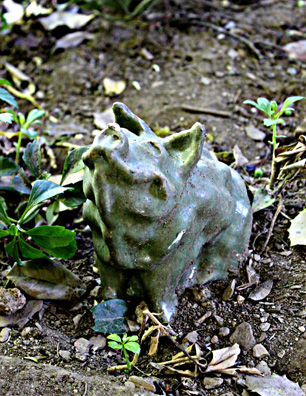Monument in Honor of Francesco Sforza, Duke of Milan

Well, this may not be the monument in honor of Francesco Sforza you were thinking about, but at least this one was completed.
The art of the Renaissance was not only decorative but also functional and utilitarian. Of course, functionality and utility included honoring the people who put the money up for the artists - or their relatives. And given that the cultures before the mid-20th century were far more outdoor oriented than ours, the resulting art was seen everywhere.
Sadly (or fortunately, depending on your point of view), a good deal of original art that was displayed on the streets and in the plazas has been removed to museums. Not all, though. The bronze statue of Bartolomeo Colleoni sculpted by Andrea del Verrocchio remains where it was erected, next to the Campo dei Santi Giovanni e Paolo in Venice.
It was probably Andrea's sculpture that prompted Leonardo da Vinci to try and outdo his teacher (yes, Leonardo was a student of Andrea) by creating what was to be the greatest sculpture of the Renaissance. No one knows exactly what Leonardo was trying to make, but most historians think it was the Sforza Horse a massive equestrian statue that was indeed intended to honor the memory of Francesco Sforza, the father of Duke Ludivoco (who was putting up the money). Alas, Leonardo's horse never got beyond the full sized clay model. It was never cast in bronze, and the model was destroyed by French soldiers when Louis XII invaded Milan in 1599.
Today there are two full size versions of Leonardo's horse, one in Michigan and the other in Milan. These are about 24 feet tall and are cast bronze. There is a smaller bronze statue, about 12 feet tall, next to the Baum School of Art in Allentown, Pennsylvania.
Note we don't say these are copies. Although lot of people praised Leonardo's model, they didn't bother to leave us a description and no drawing can be clearly identified as being the actual statue. So no one really knows what Leonardo was planning. The consensus, though, is that the final sculpture was simply a horse - not Duke Francesco astride the mount, which would have been more in keeping in the tradition of monumental commemorative sculpture.
So what was Leonardo's original design? Well, there is indeed a drawing in the Royal Collection in England of a man perched upon a rearing horse. But such a statue - even with a bit of extra support - would have been a risky venture even for experienced sculptors, and certainly on the scale Leonardo intended. This type of planning, though, would have been quintessential Leonardo who would design his art with complete disregard to any practical problems. After all, he could figure out how to solve them as he went along, non è così?
But Leonardo's patrons - the guys with the money - didn't always share his optimism. Leonardo was also known to be quite a piddler, making grandiose promises for projects, taking the down payments, and never finishing anything. So after a while Duke Ludovico asked the Florentine ambassador to write to his boss, Lorenzo de Medici, for the names of some real sculptors who could take on the task since it was doubtful that Leonardo would succeed. The letter - which Leonardo seems to have gotten wind of - is probably what made Leonardo simplify his plans to the non-rearing horse sans rider, provided that is what Leonardo's final plan was.
A lot of trouble would have been saved if Leonardo had adopted the design shown here. He could easily have made this into a 24 foot monument. But for some reason this most Renaissance of the Renaissance men was happy to study the form and motion not only of horses, but dogs, cats, birds, and ugly people as well. But he never sought to celebrate our porcine brothers and sisters. Why this neglect, we'll never know, but it is to remedy this fault that this outdoor monument was created. What Leonardo began, we have completed.
Sculpture intended for the great outdoors should be made from robust material. Marble still has some popularity, but it doesn't stand up very well in today's polluted atmospheres. Granite is a much more durable stone but is a great way to ruin your tools and also has associated health hazards (particularly the dust) when doing the carving. So today the monumental materials of choice are the traditional bronze or the newer outdoor steel (which only rusts to a thin film which then protects the sculpture). On the other hand, this statue (sorry, monument) was modeled in an "architectural clay" which when fired is particularly strong, and it was covered with a matte glaze. It should - as has the statue of Bartolomeo Colleoni - stand the test of time.
References
"A study for an equestrian monument", The Drawings of Leonardo Da Vinci in the Royal Collection, http://www.royalcollection.org.uk/microsites/leonardo/MicroObject.asp?item=3&themeid=2452&object=912358r&row=0&detail=about